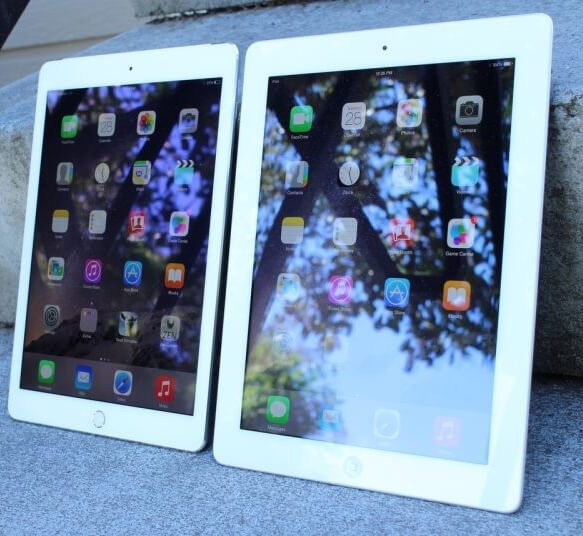Getting a new iPad involves wrapping your head around a multitude of terms to grasp its specs. One term that particularly stands out is the "laminated screen" or "laminated display"
| iPad | Display Screen Type |
|---|---|
| iPad Pro | Laminated screen |
| iPad Air | Laminated screen |
| iPad mini | Laminated screen |
| iPad | Non-Laminated screen |
Don't worry if you're uncertain about what that is and how it affects your user experience. This article will demystify what a laminated display means and its pros and cons. Ready to dive in? Let's get started.
What Is Non-Laminated Display?

Let's kick things off by discussing non-laminated displays, which are older than their laminated counterparts. This display type consists of three layers:
- A protective top glass layer,
- A touch panel for touch recognition, and
- A display panel for viewing.
These layers collectively add to the device's thickness. Air bubbles often fill the space between the layers, causing the light quality to dip due to a scattering effect.
Consequently, your display may appear hazy, with colours not reaching their full potential. Dust can also enter the air gaps, further reducing the display's clarity.
What Is A Laminated Display?
In contrast, laminated displays are newer and can be found in many premium devices, be it phones, tablets, or computers.
What makes a laminated display superior to a non-laminated one? The key difference lies in their construction:
While non-laminated displays have 3 separate layers, laminated displays merge all three into one. This results in no air pockets and no light scattering, thus improving display quality.
Benefits Of Laminated Display
Thinner display
Merging all layers into one reduces the display's thickness considerably, resulting in lightweight, thin, and sleek devices.
Enhanced visual quality
Laminated displays make colours appear more vibrant and natural. The absence of air gaps ensures no unnatural light refraction, leading to a crisper and clearer display.
Clearer display quality
A laminated display provides a bright, crisp, and anti-glare screen. Since the display is just beneath the top glass panel, the visual quality is much improved.
No parallax errors
Parallax error refers to the gap between your stylus (Apple Pencil) tip's position and the registered touch on the display. This error can be distracting for digital artists, and laminated screens have been developed to eliminate it.
Improved outdoor performance
For those needing better visibility in bright outdoor environments, laminated displays are the ideal choice. Their clear and anti-glare qualities offer a better viewing experience.

Drawbacks Of Laminated Display
Laminated displays are not without their flaws. Here are three main disadvantages:
Higher cost
Laminated displays, being the latest advancement in screen displays, come with a hefty price tag.
Greater damage sensitivity
The thin laminated screen is more prone to damage. A single crack can compromise all functionalities, as the glass protector, touch panel, and display are all integrated.
Complex and expensive repairs
Repairing laminated displays is more technical and expensive. Even minor damage to the top glass panel could require a costly replacement of the entire display.
How Does This Impact User Experience?
So, how does this all affect your experience? Three key aspects are influenced by your device's display type:
Display Quality
Compared to non-laminated displays, laminated ones offer better picture quality. They provide a natural and clear view, even in bright outdoor conditions. Additionally, laminated screens also provide anti-glare properties.
Reliability And Repairability
While laminated displays offer excellent visual quality, they are also fragile and costly to repair.
Smoother Drawing
For artists, a laminated display offers minimal lag and parallax error, making for a more natural drawing experience. This is a stark contrast to the laggy drawing experiences on non-laminated displays.
Conclusion
The primary difference between laminated and non-laminated displays boils down to their construction. Non-laminated displays have two layers with space in between, while laminated displays consist of a single, multitasking layer.
Laminated displays offer a superior visual display, anti-glare, and thinner screen. However, they are fragile and prone to damage, leading to potentially costly repairs.
FAQ
Do laminated displays make a difference?
Absolutely, laminated displays significantly improve visual quality, provide anti-glare properties, and allow for thinner devices. These benefits make a considerable difference, especially for artists.
Does a laminated screen reduce glare?
Yes, laminated screens offer superior anti-glare properties compared to non-laminated screens, making them more visible in brightly lit environments.
Is a laminated display necessary?
A laminated display can be beneficial if you plan to use your device outdoors or desire a thinner device with crisper
Can SimplyFixIt fix laminated screens on iPads?
Yes we can. Although the cost of fixing a laminated iPad screen is more expensive than a non-laminated screen, the quality of the display is so much better, plus in most cases we're around half the price of Apple. For more infomation on how to get your iPad fixed, go to